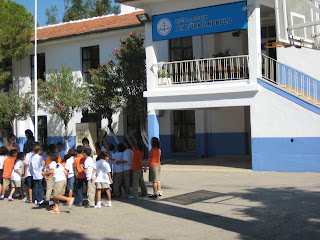 | |
| Here is an explanation of how globalization began....it is certainly not a new concept.....:-) |
 |
| A recreation of the ancient pottery kilns for firing the amphorae |
 |
| For my pottery-making friends, Brenda, Geoff and Barbara, here is a depiction of the firing of the ancient amphorae. |
 |
| This huge cactus was covered with buds about to bloom! Wish I could see them! |
 |
| A typical Muslim grave marker; I saw a whole cemetery full of these on the way to Akyarlar. |
 |
| I read this on a mulberry tree....it made me wonder whether Shakespeare might have plagiarized the story of Romeo and Juliet! |
This morning after breakfast, I headed for Bodrum Castle
to visit the Museum of Underwater Archeology, the brilliant idea of an American professor (named Bass) from the University of Pennsylvania
who had participated in some archeological digs in Turkey while still a graduate
student in the 1960’s. Together with his
Turkish counterparts, they conceived this fascinating museum in the heart of
the medieval castle which was built as a stronghold by the Knights of St. John
after they were chased from Rhodes and before they ended their days on the island of Malta.
On my way to the castle, I stopped to watch Turkish children
during their recess playing ball in the school courtyard. The school is right near the sea, and all the
tourist hubbub. I wonder what it must be
like to grow up in such a place which resembles a sort of paradise for both
foreign and Turkish tourists. Many of
the tourists here now are Turks, though today I also heard French, German,
Dutch, Russian and Bulgarian.
I spent two and a half hours exploring the excellent
exhibits of artifacts found under the sea along the Turkish coast, including an
ancient Egyptian cargo from the 14th century B.C. with bronze-age
tools, scarabs and a tiny golden deity figure believed to be the protector of
the ship. There was also an Anatolian
ship from the 5th century B.C. that is referred to as the
glasswreck, as it was bearing a huge amount of glassware, as well as thousands
of shards of broken glass. This was an
early form of recycling, as the shards were collected by peddlars and resold to
be melted down and formed into new glass objects. The museum has one of the four largest
collections of ancient glass in the world.
Another of the museum’s impressive collections is that of
huge clay amphorae used to store and transport oil, wine and other foods. These vessels are tall, with two handles, and
a cone-shaped, cylindrical body. The
museum has literally hundreds of them that were found in the various shipwrecks
on display. Some of the ships themselves
are partly reconstructed, using the pieces of hull and plank that were
found. Since these shipwrecks are
thousands of years old, not much remains of the ships themselves, but amazingly
as much as 20% was found in some cases if the hull was resting in sand.
Other treasures I viewed included coins from numerous
ancient civilizations, jewelry, an ancient and primitive chess set, grooming
tools including a delousing comb, cooking pots and utensils, swords, hatchets, anchors….The history of anchors was
quite interesting. Originally, they were
just huge stones, but then wooden anchors were developed. To make them heavier, deep grooves were
carved into the base of the anchor, then liquid metal was poured in. These eventually evolved into the heavy iron
anchors we normally think of.
The castle has a number of towers, each dedicated to a
different language group of the Knights….hence the English, German, French, and
Italian. Inside the Snake Tower
which was used as a hospital, there was a display devoted to objects related to
health, life and death, including tiny carved figures displaying different
maladies, some primitive surgical instruments (ouch!), and a carved figure of
Priapus, son of Aphrodite and Dionysus.
If you have never seen a depiction of Priapus, here is what Wikipedia
has to say about him J:
In Greek mythology, Priapus or Priapos (Ancient
Greek: Πρίαπος), was a minor rustic fertility god, protector of livestock,
fruit plants, gardens and male genitalia. Priapus is marked by his absurdly oversized,
permanent erection,
which gave rise to the medical term priapism. He
became a popular figure in Roman erotic art and Latin
literature, and is the subject of the often humorously obscene collection
of verse called the Priapeia.
Thus ended my tour of the underwater treasures museum and
Bodrum castle. I enjoyed a break from
the sun in the pleasant shaded tea garden of the museum where I drank Ayran (a
salty liquid yogurt drink), and ate various dried fruits stuffed with hazelnuts,
almonds and pistachios. I reserved my place on the bus to Ephesus tomorrow
morning. I have to meet the driver in
front of the new mosque (the one with the grocery store in the basement level!)
tomorrow morning at 6:45 am!

























No comments:
Post a Comment